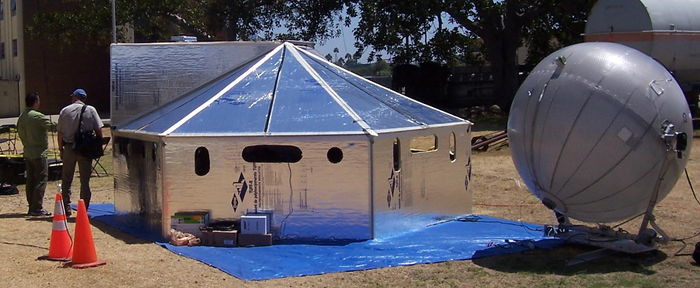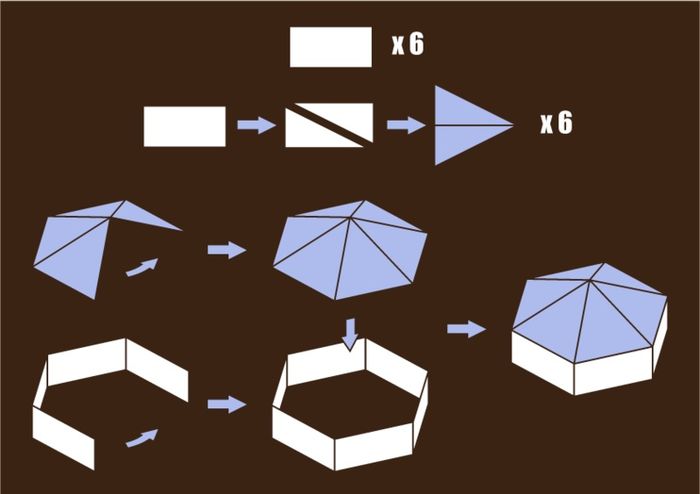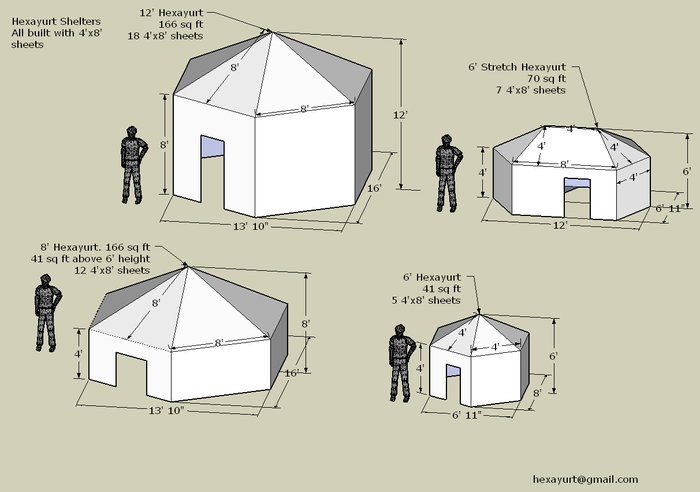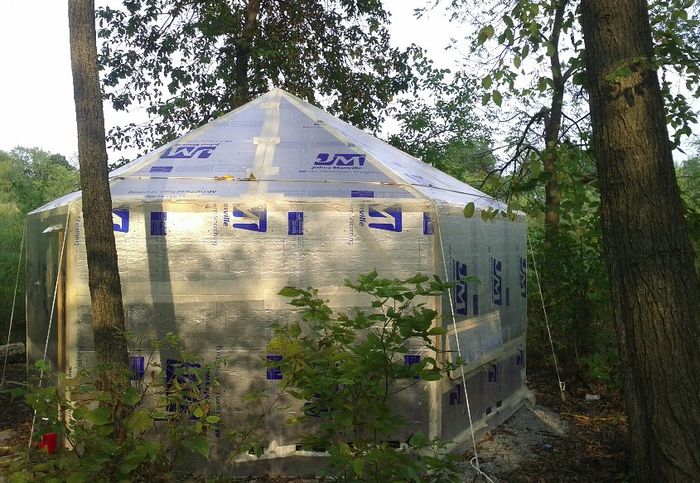Hexayurt construction


Introduction
This article is intended to provide a detailed description of the construction of the hexayurt so that the successes can be replicated and the few mistakes can be avoided.
The design applied at Factor E Farm as the Paul Newman Center for Temporary Housing (kind of kidding... Rob, call it what you like) was a perfect hexagon with 6' walls, 10' peak, and 14' foot width. It will comfortably house 3-4 people and should last about 10 years, given precautions taken. It is a tension structure, so that the building itself will give it structural support.
Rob, who has a history and family background in building construction, was quite skeptical of the structural integrity of the building. It proved to be excellent, and come together better than was thought.
Step 1: Materials
Materials aquired were:
- 14? 4x8 OSB boards
- 100' of metal flashing (about 5-6" wide, and of substantial thickness)
- about 18 2x4s (for the roof, they dont need to be anything too fancy, we used salvaged wood that was fairly thin)
- Lots of screws (we used drywall, though we would encourage stainless steel)
- Paint
- Tar (dont need too much)
- Gravel (for the foundation)
- Vinyl steal material (this was an extra precaution)
Step 2:Painting and Tarring, Site Prep and Foundation
Painting and Tarring
The next step was to paint and tar the OSB boards. All of the OSB boards were painted on all edges, as OSB's weakness is moisture on the ends, which causes it to swell and rot. The paint applied on the edges, corners and such 3 inches in to the board should quell this.
Additionally, Tar was applied to the bottom edge of 6 of the OSB boards, about 4 inches in, so that high water would be deterred from any prolonged exposure to the boards.
Site Prep and Foundation
We used open engineered technology for site prep! but any rototiller will do. We used the lifetrac with open rototiller to break up the soil, then we went through, measured everything out, ensured there was more than enough space for the walls, then pulled out roots, broke up clumps, and leveled it out with the rakes, and in the process stomped it down with our boots. We used a 2x4 and level to ensure the grade was correct.
Then, we dumped gravel at the assumed edges of the structure, measured it out, and then tamped it down at about 5-6 in wide by 3 in thick, leaving space for a door.
Also, make sure to clear the area from any meddling chickens. (Richard: One of them left a little gift for me on the ground that my hand discovered while making the wall panels)
Step 3: Cutting
After the paint and tar dries, the next step is to start cutting the boards. Because we decided on 6' walls instead of 8', we were able to eliminate 3 OSB boards from the materials list and cut 3 in half for the topmost board.
- So, cut 3 OSB boards in half, making them 2'x8'.
- Cut 6 OSB boards in half diagonally, corner to corner for the pinweel roof (take extra precaution to ensure that these are straight and true, as they will ensure that the roof comes together well in the end. Also, if you are using foiled boards, cut them in half in opposite ways, so as to provide all foil on top)
- Cut 12 2x4s to have a long edge and a short edge, at a 30 degree angle, so that they can be linked together inside horizontally and form the hexagon with the walls
- Cut flashing strips into 6 8' strips and 6 6' strips for the walls, then additionally 6 more 8' strips for the roof
- Using a hammer punch, punch along roof strips and wall strips all along the edge, about 2-3cm in from the edge, making double punches near the ends. For the vertical wall strips, make sure that they are more dense. 2 people can set up a process doing this and have it done very quickly. Make sure to wear gloves as the flashing has sharp edges!!! (richard: i learned this the hard way. twice...)
For speed, have one small team cutting and punching flashing while another team draws and cuts board.
Step 4: Panel Construction
Wall Panels
With tar side down, attach 4'x8' OSB boards to 2'x4' boards, using the 2x4 with the long edge against the boards. Ensure that they are all flush, and that the 2x4 is evenly attached to both boards!
After this, attach flashing strip to one edge (left or right, doesnt matter, just keep it consistent throughout).
A trick Rob discovered with the flashing, to keep it flush as possible with the board, is to use the screw gun at an angle, pointing away towards the loose flashing end. It doesnt need to be an extreme angle, just enough to pull it taught when the head goes in.
Then, attach the flashing and the topmost 2x4 to the top of the 2'x4' OSB board. Leave a consistent space between the top of the 2x4 and the top of the OSB board (we left about 1/4 in). This makes placing the roof much easier and safer.
When attaching any of the flashing, ensure that you are placing less than half (more like a third) of the width of the flashing on the 1st board. This will ensure a good amount will be left to attach to the other board, whether roof or wall, given that the angle between will take up some of that width.
Roof Panels
Make a triangle with the panel pieces, screwing them into the 2x4 underneath evenly. Ensure that all is flush and that the bottom edge of the 2x4 is far enough away from the bottom edge of the panel to ensure that it wont get in the way when raising the roof. These 2x4s do not need to attach to the rest of the frame, as the roof is self supporting.
Then, like the wall panels, attach flashing consistently on one side, leaving width space for angle and attachment.
2008 FeF Hexayurt Construction
here is a link to photos and videos that were taken in 2008 when the first hexayurt was built at FeF: http://files.howtolivewiki.com/open_source_ecology_plywood_hexayurt_build/footage%20092708/?C=S;O=D
Hexayurt Review
Chris DeAngelis 03:34, 12 August 2012 (CEST)
The hexayurt is still standing, but the osb pannels are begining to fall apart. The leather roof is still in very good shape. Additional windows were added for ventilation in the summer. The door has fallen off it's hinges. Never the less, i think with just a few additions to its design it could be a 10 year design, currently i think it is only a 5 year design. The current critical design successes are as follows:
- it is still standing
- it is very spacious for 1 or 2 people
- the walls are strait (not like a dome), so furniture fits inside very well.
- it is fairly quick and cheap to build
the following are shortcommings at this point (5 years after build):
- it is hot in the summer
- it is cold in the winter
- the OSB is starting to warp heavily
- the door hinges have ripped through the door
Jeb 04:29, 1 September 2009 (PST)
I also recommend the rocket stove book mentioned above, and have built some small "pocket rocket" designs to experiment with so far. Building the fancy version with cob thermal storage battery would be ideal for maintaining comfort, but probably time consuming enough for a dedicated project visit itself. The battery woodgas stoves look excellent for outdoor cooking on the go, but probably not much good for heating inside without draft ventilation. However, the new patio model would probably work great in a tipi by comparison.
Andrewed 04:19, 26 May 2009 (UTC)
Your results are perfectly consistent with any use of an uninsulated structure on exposed dirt in winter in Missouri, with a poorly functioning stove. Even 1" styrofoam boards on the ceiling, 1/2" styrofoam boards on the walls, and a plastic tarp on the floor would have helped you immensely. Also, the use of a rocket stove from Aprovecho in Oregon (plans available from them) or the very cheap woodgas stove that Vinay recommends on his website would have kept you warm without the extreme hassle with smoke and complicated chimneys that you suffered. Better luck this winter?
Andrewed 04:19, 26 May 2009 (UTC)
Your results are perfectly consistent with any use of an uninsulated structure on exposed dirt in winter in Missouri, with a poorly functioning stove. Even 1" styrofoam boards on the ceiling, 1/2" styrofoam boards on the walls, and a plastic tarp on the floor would have helped you immensely. Also, the use of a rocket stove from Aprovecho in Oregon (plans available from them) or the very cheap woodgas stove that Vinay recommends on his website would have kept you warm without the extreme hassle with smoke and complicated chimneys that you suffered. Better luck this winter?
Vinay Gupta 16:05, 13 February 2009 (PST)
Ah, yes, I'm not surprised than an uninsulated plywood structure was cold in winter. The Hexayurt geometry does not have decisive advantages in heat retention over other building shapes.
Jeremy 10:12, 13 February 2009 (PST)
I tried living in the hexayurt for a little while, here are my thoughts. It was in November 2008. Weather was cold but not much rain or snow yet. Yurt was quite sturdy and kept the wind and water out, but was cold inside. Before Bob left we put the 55 gal. drum stove in and cut a hole in the side for the flue that had two bends. The stove was and is a difficulty, hard to light and very smoky. I slept on the futon mattress we had on the dirt floor of the yurt at the time. The floor was still kind of damp, I guess it was built when the ground was not entirely dry or water had gotten under the walls underground. In the morning it seemed very damp inside the yurt, which I think was from the damp ground. I don't know how it would be if it had a good stove. Nick took over the yurt when he came here. We moved the stove and had the flue go straight up to have a better thermal draw. With the stove going the yurt is pretty warm, but the door needs to be opened a lot to let the smoke out. It doesn't have insulation so it cools off quickly without a fire constantly going. The drum stove either burns out quickly and leaves the yurt cold in the morning or burns extremely hot and smoky all night making the yurt almost too hot and smoky to stay in. A good stove might leave it still pretty cold in the morning but it could be fired up easily and the temperature regulated better. Smoke still seems like a problem to me, even with a good stove in the cordwood hut.
Links
- Main website: "The Hexayurt Project: Free Hardware housing for the world"
- Appropedia: Hexayurt Playa
- Appropedia: Hexayurt Playa Checklist - More specifically, assembly instructions for the one Vinay built on the playa at burning man. Lots of options for construction now!
- Appropedia:Hexayurt book - tons of info.
- Wikipedia: Hexayurt

